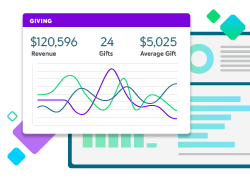Top 4 Donor Prospect Research Tips Leading to Bigger Gifts

Prospect researchers are up to their ears in data—and usually with requests. Responding to individual needs probably occupies most of your day but reacting to requests is not the best way to spend your time. To have the biggest impact on your organization, you’ve got to turn the tables and start proactively researching so you can identify the strongest prospects.
To help you take the reins and contribute more donors and dollars, here are the top four most effective tips for prospect research.
1. Make More Accurate Gift Capacity Estimates
Gift capacity is a sensitive subject. You can’t work with major donors without having a few missed estimates. Sometimes you just don’t have access to the right data. Plus, you see just the tip of the iceberg when doing research. Only when a gift officer starts talking to a prospect via the qualification and the cultivation process can you know how much someone will give to your organization. But learning how to master gift capacity will help your team know how to best approach a prospect and draw up accurate, thoughtful proposals. Here are three methods for fine-tuning your gift capacity estimates.
Cross-check for accuracy.
Every institution has a slightly different gift capacity formula, but you can improve its effectiveness by verifying your data points across multiple sources. If you don’t have time to cross-check all your prospects, focus on the top 5%. These prospects have both the strongest affinity for your institution and the highest capacity to give.
Trust your software to do some of the work for you.
Prospect research takes a lot of time, but software that aggregates donor wealth and affinity information will free up your time for in-depth research. Use data-driven software to sketch out your prospect’s basic details, and tap into predictive AI tools to evaluate and qualify donors. Just make sure you’re pulling from different sources when you perform your manual cross-check. You’re not cross-checking if you get information from the same database as your software.
Hone your intuition.
If there are wealth markers or circumstances that weren’t considered in the formula, take those into consideration for a more accurate estimate. You’ve done the research on your prospect. You can see the bigger picture. Make the case for adjusting the ask amount based on details you find compelling. Fine-tuning your understanding of a prospect’s real-estate holdings is a prime example. A heavily mortgaged $1 million condo in San Francisco indicates a different financial situation than a $1 million home paid for in cash in a less pricey market. Your job is to tell the part of the story that the numbers cannot.
2. Analyze Your Prospects’ Philanthropic Interests
You’re a matchmaker. Your discovery work connects your institution to enthusiastic donors and prospects to causes they find meaningful. Be nosy! You wouldn’t set up friends on a date without knowing if they’re compatible. The same should be true of your institution and potential major donors. Find out how your prospect’s philanthropic priorities align with your institution. Pinpointing exactly where your institution’s needs overlap with a prospect’s interests leads to donations instead of missed connections.
Uncover the minutiae.
Knowing the details helps your frontline fundraisers with everything from asking the right questions during a meeting to making a thoughtful proposal. Research what compels your prospect to give. Find out where they donate already and if they’re involved in volunteering or serving on a nonprofit board. Is there a connection between the causes they’re passionate about or the organizations they give to? Get it all out there.
- PRO TIP: Using a wealth screening solution to help uncover your prospect’s philanthropic giving elsewhere or their associations with other nonprofit organizations will reduce the time it takes to uncover the minutiae.
Discover connections.
Let’s assume you’re a fundraiser for an educational institution. Once you have uncovered a prospect’s interests, it’s easier to find the campus connections that could compel a gift. Check to see if your prospect serves on a committee, attends events, or supports the same causes as involved faculty and staff or alumni donors. Giving is a social activity and donors come together around causes they care about. When your gift officers know which relationships could be useful, they can facilitate an introduction. Often, a thoughtful touchpoint outside of advancement can be a catalyst for supporting a specific project.
Sense opportunity.
A good researcher schedules time to step back and look at prospects collectively. You have access to more research data than anyone else on the team which means you are uniquely positioned to think strategically about the trends you’re seeing. Are you noticing multiple prospects have similar philanthropic priorities? Keep a list—it could become the basis for a special project, event, or campaign.
Prioritize Who Gets Research Time
Your research hours shouldn’t be wasted finding qualified prospects—software trawling your donor database can do that. Instead, make the most of your time by providing in-depth information on the prospects already qualified by your software. There are three important pre-qualified groups where additional research will have a meaningful impact on a gift officer’s ability to solicit a donation. Here’s how to focus your research time:
Uncover the top 5% of prospects for both wealth and affinity.
These folks are wealthy, but they also demonstrate a strong connection to your institution. Their affinity makes them more likely to donate, so in-depth research on these prospects is a great investment.
Search for patterns among donors with the largest cumulative giving balances.
These are known, generous donors. Dig into the details surrounding their previous gifts to find out if they share a theme or demonstrate a clear interest in a certain cause. Learning more about these donors helps position your team to invite them to partner for specific projects and initiatives.
Identify donors who have faithfully contributed three or more fiscal years in a row.
These donors are committed to you. They’re great candidates for more generous giving. Once you know their interests and have a more accurate picture of their wealth, you’ll have the information you need to formulate a stretch pledge that expands their philanthropy with you.
4. Highlight Emerging Prospects
Great prospect researchers are always thinking about the donor pipeline. Make proactive research on emerging prospects part of your weekly routine. The work you do now won’t identify current major gift prospects, rather it will identify future candidates. When you know more about your current committed midlevel donors, it’s easier to create programming that will help them grow their philanthropy with you over the long term.
Filter for the strongest prospects.
Chasing down information on every midlevel donor is too much to handle. Concentrate your efforts on the top 5% of annual giving donors—these folks could already be in leadership annual giving programs, or they could still be unidentified. They will demonstrate strong affinity to your institution and are growing financially or have shown increasingly generous donations.
Surface new information.
Your database may or may not have a lot of information on new prospects. Get as much basic research done as possible using software tools. Use cross-checking and manual research to fill in the gaps and paint a more vivid picture. You’ll want the same information on these donors as on your major giving prospects. Discover their interests by noting how they’ve designated past gifts, which philanthropic causes they support, and where they volunteer.
- PRO TIP: Map out donors’ growing wealth more thoroughly and consider producing an estimate on their capacity to give.
Work as a team.
Working with emerging prospects may require some cross-functional teamwork. Make sure whomever plans events or sets programming has access to your research. Your emerging prospects would be great candidates for an event, project, or program designed to expand their philanthropic role. Odds are that annual giving, alumni relations, and major giving will want to be part of the push.
What’s Next: Moving Forward with Proactive Research
Prospect researchers today have more time to proactively identify potential donors since computer software has taken over basic wealth and affinity screenings. When you aren’t bogged down with prequalifying prospects, or fetching information on request, you have the opportunity to provide the concrete details that help frontline fundraisers successfully solicit donations. Prospect researchers play an incredibly powerful role within the larger fundraising landscape. Quality prospect research can completely recalibrate the direction of major giving campaigns. By increasing the supply of actionable information available on prospects, you will lay the groundwork for better quality donors and larger gifts.
The Nonprofit CRM Built for Fundraisers
Find out how Blackbaud’s Raiser’s Edge NXT® fits your organization.




